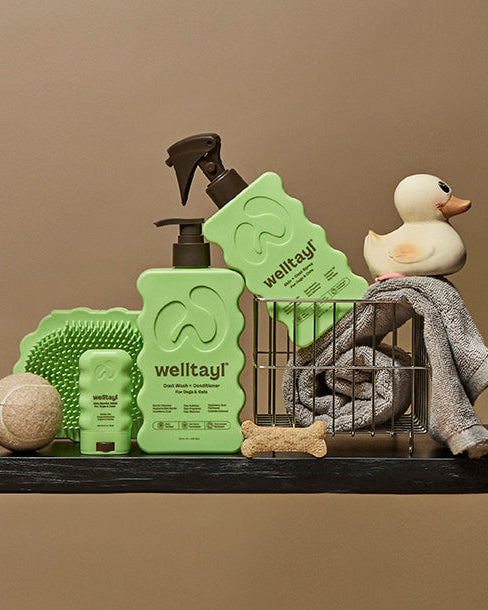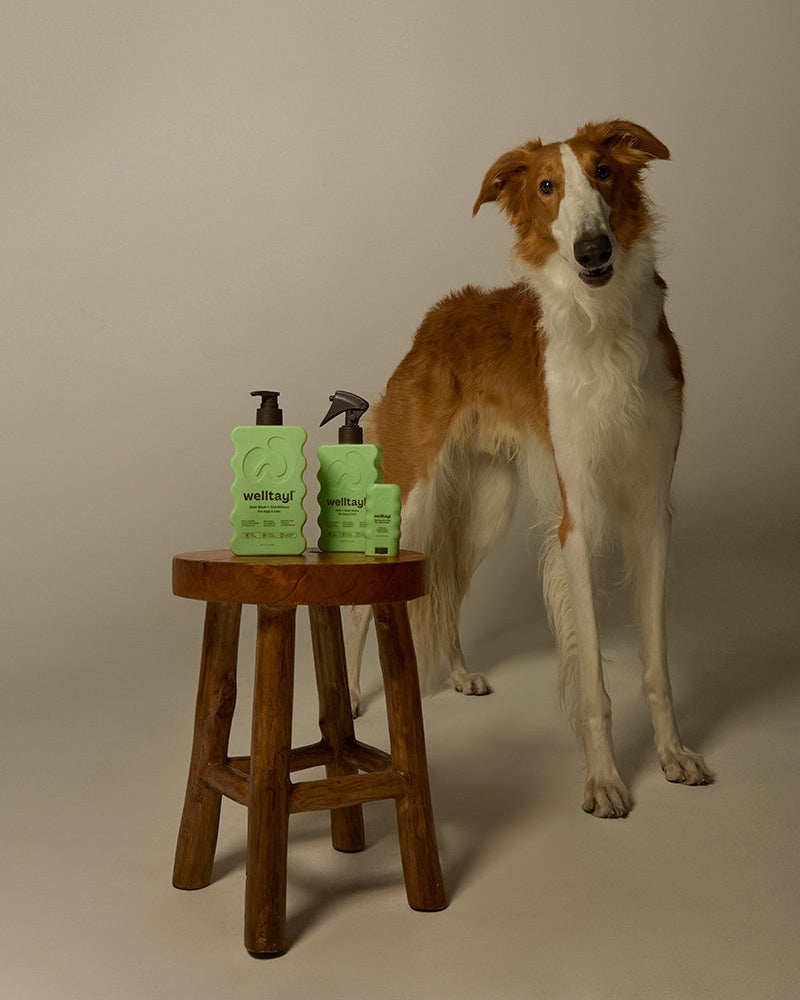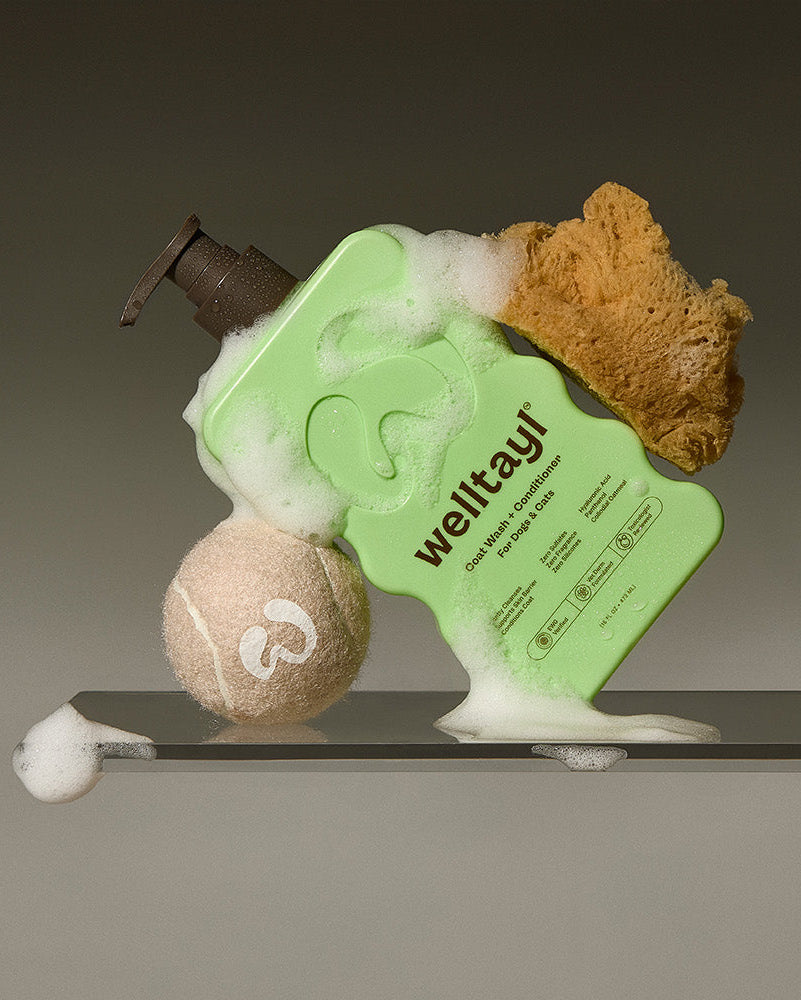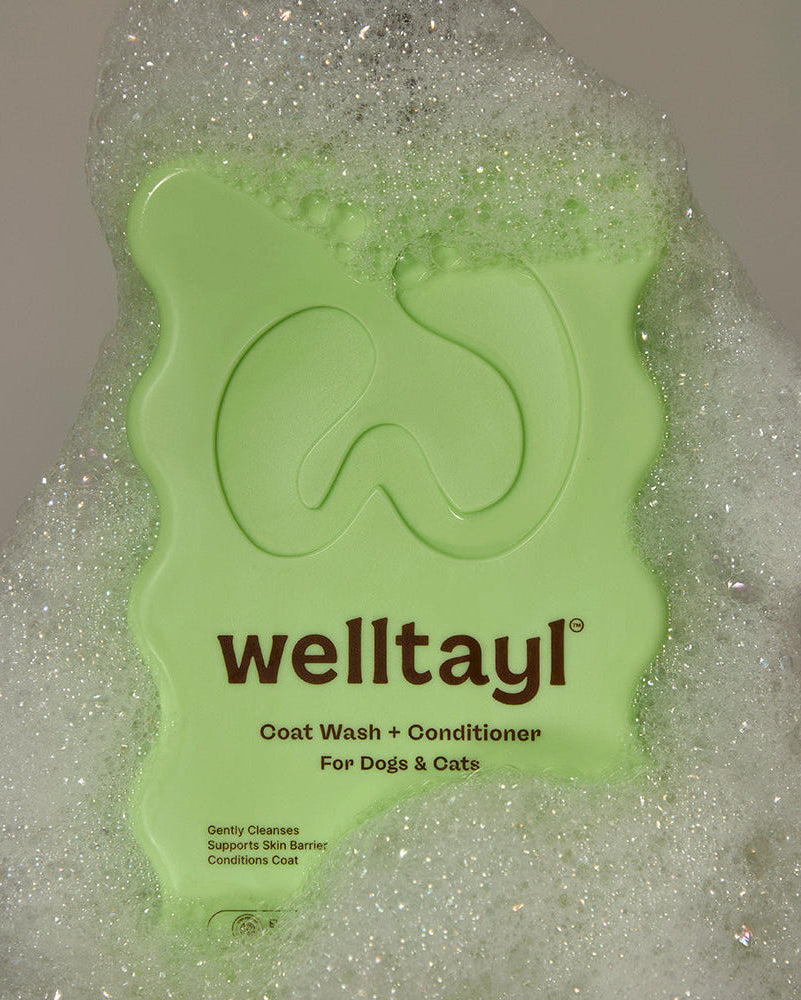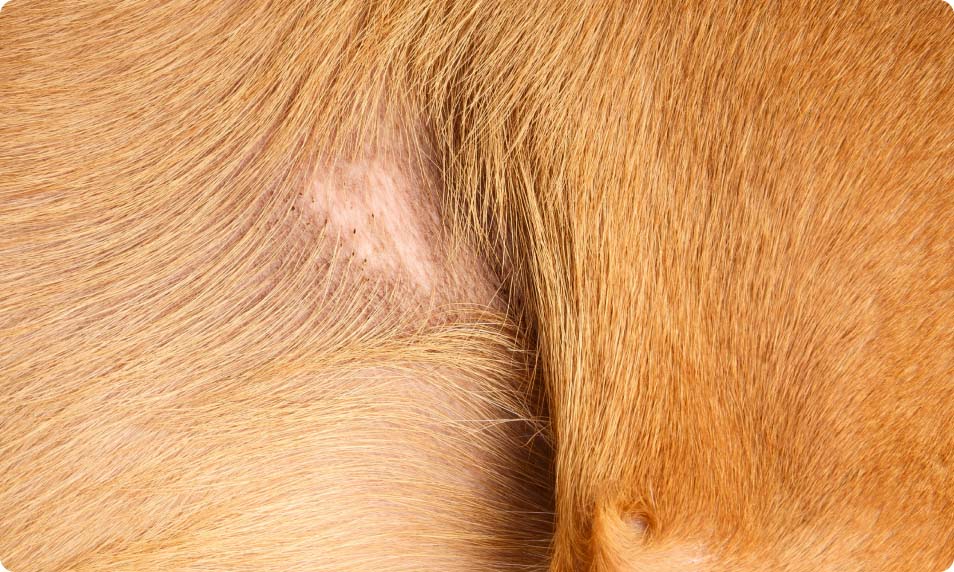When your dog starts scratching more than usual, seems uncomfortable, or has red, irritated skin, they could be dealing with dermatitis. Understanding what's causing their discomfort and how you can help them is crucial. Keep reading for a clear breakdown of the causes and solutions for dermatitis in dogs.
Table of Contents:
- Key Takeaways
- Causes of Dermatitis in Dogs
- Signs and Symptoms of Dermatitis in Dogs
- Types of Dermatitis in Dogs
- Diagnosis of Dermatitis in Dogs
- Preventing Dermatitis in Dogs
- Living with a Dog with Dermatitis
- Conclusion
- Frequently Asked Questions
Key Takeaways
- 🐕 Definition and Causes: Dermatitis in dogs is a skin condition that results in itching, redness, and discomfort. It can be caused by environmental allergens, food allergies, parasites, and fungal, bacterial, or yeast infections.
- 🔍 Diagnosis: Effective diagnosis involves veterinary examinations, skin tests like skin cytology or scrapings, and sometimes blood tests to identify allergens or other underlying issues.
- 🌼 Types of Dermatitis: Common types of dermatitis include atopic dermatitis, flea allergy dermatitis, contact dermatitis, and food allergy dermatitis. Each type has specific triggers but symptoms tend to overlap, making consultation with your vet an important step in the path to appropriate treatment.
- 🛠️ Treatment Options: Treatments may include medications (steroids, antibiotics, antifungals, antihistamines), topical treatments (special shampoos, ointments), dietary changes, and possibly allergy shots (immunotherapy) depending on the underlying cause.
- 👀 Signs and Symptoms: Key indicators are excessive scratching, red or inflamed skin, hair loss, and sometimes more severe symptoms like scaling or oozing of skin.
- 🚫 Prevention Tips: Regular grooming, proper nutrition, and maintaining a clean environment are crucial. Regular vet check-ups help catch and manage dermatitis early.
- 📝 Additional Resources: For ongoing support and advice, subscribing to the Welltayl newsletter offers continuous updates and tips on managing your dog's health.
Understanding these aspects can help dog owners identify and treat dermatitis effectively, helping their pets lead comfortable, happy lives.
Dermatitis in dogs isn't just about being itchy; Understanding what's making your dog itch is the first step to helping them feel better. Whether it's changing their diet, avoiding certain plants on your walks, or getting them on the right medication, there's a lot you can do to turn those scratches into satisfied tail wags.
Causes of Dermatitis in Dogs
When trying to get to the root of the cause, a little detective work can go a long way when it comes to dermatitis. Various factors might be to blame for your dog's skin problems, from environmental allergens to their diet. Identifying the cause is the first step in helping your furry friend feel better.
Environmental Allergens: Imagine running through a field of flowers and coming out with a bunch of itchy spots. That’s often what happens to dogs with environmental allergies. Allergens like pollens, dust mites, and molds can cause skin irritation both by contacting the skin and by being breathed in
Food Allergies: Sometimes, what your dog eats can make them itch and scratch. Some dogs are allergic to common ingredients in dog food like beef, chicken, or grains.
Parasites: Tiny bugs like fleas, ticks, and mites are not just a nuisance; they can cause serious skin issues. For instance, mange mites such as Sarcoptes (scabies) and Otodectes (ear mites) can make your dog's skin extremely itchy.
Skin Infections: A fungal or yeast, or bacterial infection can cause your dog persistent itchiness and discomfort that they can't relieve on their own. Owners may also notice an abnormal odor from the skin.
Remember, solving the mystery of your dog's dermatitis usually begins with a visit to the vet. They can perform tests to pinpoint the exact cause and recommend the best course of treatment. Sometimes various causes of dermatitis can be present simultaneously.
Signs and Symptoms of Dermatitis in Dogs
Dermatitis in dogs can make your furry friend feel really uncomfortable. It’s like having a constant itch you can never quite scratch or being stuck in clothing that constantly irritates your skin. Luckily, if you know what to look out for, you can help your dog feel better.
Recognizing the Signs of Dermatitis
Spotting the signs of dermatitis early can make a big difference in how you help your dog. The most common sign is itching, but it’s not just any itch. Your dog might scratch, lick, or bite their skin more than usual, anywhere on their body. Think of it as if you had a mosquito bite that just wouldn't quit itching; your dog feels something similar, but all over.
Another sign to watch for is redness or rashes, kind of like when your skin gets irritated after touching something you're allergic to. You might also see small, pimple-like bumps on their skin. If your dog seems to be losing more hair than normal or is constantly shaking their head, these can also be cries for help. It's these little changes that, when noticed early, can prevent bigger issues down the line.
Symptoms that Indicate Severe Dermatitis
Sometimes, the signs of dermatitis in dogs can get more serious. If the itching turns into areas of thickened, darkened, or scaly skin, it's like the dog's version of a really bad skin reaction. These areas can be painful to the touch, similar to how bad sunburn feels when you press on it.
In worse cases, you might notice oozing sores, a strong, unpleasant smell, or even patches where the hair has fallen out. Imagine wearing a pair of shoes that rub your feet raw to the point of getting blisters – severe dermatitis can be that uncomfortable for your dog. Plus, seeing pus-filled blisters or lots of scabs is a sign that things have gotten pretty bad, like when a small cut gets infected because it wasn't cleaned properly.
Types of Dermatitis in Dogs
Dermatitis is a skin issue many dogs face, leaving them itchy, uncomfortable, and unhappy. But not all dermatitis is the same. Knowing which type your furry friend might be dealing with can help you find the right way to make them feel better.
Atopic Dermatitis
Atopic dermatitis is like that friend who's allergic to everything - pollen, dust, mold, you name it. Dogs with atopic dermatitis have super sensitive skins that react to all these usually harmless things in the environment. This can happen when the pet’s skin comes in contact with the allergens or when the pet breathes in the allergens. It starts with a bit of itchiness, but can quickly turn into redness, intense scratching, and even secondary skin infections if not treated. Keeping an eye out for any signs and getting them checked by a vet early is key.
Flea Allergy Dermatitis
This one's a bit of a double trouble. Imagine being allergic to flea bites. One tiny flea can make your dog itch like crazy, leading to them scratching, biting, and sometimes creating sores on their skin. Now imagine if besides the itching fleas cause anyways, your poor pup is actually allergic to the fleas saliva. . The best defense here is a good flea control routine to keep those pesky fleas at bay. And yup, your vet's advice can be super helpful in choosing the right flea prevention method. It's important to note that over-the-counter (OTC) flea medications are often ineffective and, in some cases, dangerous. Unlike veterinary-prescribed flea control products, many OTC options have not undergone rigorous testing for safety and efficacy. Similarly, natural remedies are generally not effective and may even be harmful to your pet.
Contact Dermatitis
Contact dermatitis happens when your dog's skin doesn't agree with something it touches, like when you get a rash from wearing a bracelet you're allergic to. It could be anything from the soap you use to wash their bedding, to the plants they love to roll around in when outside. You'll notice red skin, itching, or even hair loss in the spots where they made contact with the irritant. Keeping track of the location of the irritation and when it occurs can help you pinpoint what's causing the problem and enable you to avoid it in the future.
Food Allergy Dermatitis
Yes, dogs can have food allergies too, and it can affect their skin. Imagine eating something that makes you feel super itchy afterward; that's what it's like for dogs with food allergies. They might get itchy, have gastrointestinal problems, or even chronic ear infections. Finding the culprit food ingredient can be tricky, but with the help of a vet, you can figure out a diet that keeps your dog happy and healthy.

Diagnosis of Dermatitis in Dogs
Diagnosing the underlying cause of dermatitis in dogs is crucial to help your furry friend feel better. Let's dive into how vets figure out the cause of skin irritation and what you can do about it.
Veterinary Examination
First off, your vet will do a thorough examination of your dog. They'll check for signs of dermatitis such as redness, scales, bumps, and hair loss. Fleas can also be visible on a physical exam. Knowing where the itch is helps a lot. For instance, ear scratching might suggest a yeast infection, while nibbling on the feet could point to an allergy. This physical check-up gives vets clues on what tests might be needed next to pinpoint the problem. Your vet might also ask about your dog's home environment, diet, and if they've been around other itchy dogs.
Skin Tests
A variety of skin tests are often necessary to diagnosing causes of dermatitis. Skin cytology involves taking a small sample from your dog’s skin and checking it under a microscope. This test helps identify yeast or bacteria that might be causing trouble. Another method, skin scraping, collects skin cells to look for mites that like to hide in the deeper layers of the skin. If allergies are suspected and severe enough, intradermal allergy testing (IDAT) may be recommended and is typically only performed by veterinary dermatologists. This involves injecting tiny amounts of different allergens into the skin and observing for the severity of redness and swelling that follows to determine exactly what environmental allergens a patient is allergic to and how bad.These tests are usually quick, but some dogs might need mild sedation to stay calm. The goal of IDAT is to create individualized immunotherapy.
Blood Tests
Blood tests are another route to diagnosing causes of dermatitis in dogs. These tests can reveal conditions like hormonal imbalances that can contribute to skin problems. They can also check for specific allergies. While blood tests for allergies aren't always the first choice due to sensitivity issues, they're less invasive than skin tests and might be a better option for some dogs.
Remember, once the cause of dermatitis is identified, your vet can tailor a treatment plan to get your dog’s skin back to being healthy and itch-free.
Treatment for Dermatitis in Dogs
After figuring out your dog has dermatitis and determining the underlying cause, it's time to talk about treatment. Some causes of dermatitis take place simultaneously so sometimes multiple types of treatment may be necessary for best results.
Medications
Medications play a big part in calming down skin issues. Steroids can quickly reduce swelling and itchiness, but they're like a quick fix and can cause more harm than good if used incorrectly.
Antifungal meds tackle yeast infections, which sometimes join the dermatitis party. Antibiotics are necessary in cases of deeper or widespread bacterial skin infections.
Antihistamines are like the allergy fighters you might use, and can be an option for mild itch related to allergies, but do not tend to work as well for moderate or severe itch. There are also medications like Apoquel or Cytopoint which target allergy related itch specifically. These medications are specific to veterinary patients and are not available for humans. Each dog is unique, so the vet will find out what works best.
If mites or fleas are present, then medications to kill these organisms will be necessary as part of treatment.
Topical Treatments
Imagine if you had a lotion that could make itchiness go away. That's what topical treatments can do for dogs. Special shampoos can cleanse and soothe your dog's skin, needing to stay on the skin for a bit to do their magic. Medicated shampoos can be used in case of infection or certain fungal infections, like ringworm. Some spots might also get a dab of ointment to help heal faster. Repeating these baths on a regular basis could be a game-changer.
Dietary Changes
Sometimes, what your dog eats can affect their skin. A special diet might turn things around, adding in foods that are kind to their skin or avoiding ones that your pup may be sensitive to. Ingredients like omega-3 and omega-6 fatty acids are superheroes for skin health, acting like natural soothers. Want to dive deeper into how food affects your dog's health? Sign up for the Welltayl newsletter.
Immunotherapy
For some dogs, allergy shots (also known as immunotherapy) can be a long-term solution. Imagine giving your dog a tiny bit of what bothers them, so their body gets used to it and doesn't freak out anymore. It's a bit like becoming friends with the enemy. This treatment, known as desensitization, takes time and patience, but it can lead to less scratching and more tail-wagging.
Taking care of a dog with dermatitis might seem like a lot, but you're not alone. With these treatments and the right advice from your vet, you can help your dog lead a happier, itch-free life.
Preventing Dermatitis in Dogs
Keeping your dog's skin healthy is a big deal. Just like us, dogs can get irritated skin, but they rely on us to help them stay itch-free and happy. Here's how you can keep dermatitis at bay and make your furry friend feel great.
Regular Grooming
Think of grooming your dog as establishing a ritual that promotes that their coat and skin stay healthy. Using the right shampoos and brushes can make a big difference in keeping their skin in tip-top shape, like the Welltayl Coat Wash + Conditioner and Bath Brush. Regular baths help wash away allergens and dirt that can bug your dog’s skin, but it's key not to overdo it because too much bathing can dry out their skin. Brushing helps spread natural oils through their coat, keeping their skin moisturized and healthy. Want to learn more about neat tricks and products to keep your dog’s skin and coat radiant? Sign up for our Welltayl newsletter for expert advice right in your inbox.
Proper Nutrition
Just like you feel awesome when you eat your favorite healthy snacks, your dog's skin thrives on good nutrition. Foods packed with omega-3 and omega-6 fatty acids can be like a magic spell for skin health, making your dog's coat shiny and preventing itchy skin issues. Not all dog foods are created equal, so it's important to choose ones that support skin health. You can also consider adding a veterinary formulated fish oil or omega-3 supplement to their diet. Wondering which foods are best for your companion? Join our Welltayl newsletter and get the scoop on top-notch nutrition tips that’ll have your dog feeling wag-tastic.
Regular Vet Check-ups
Catching up with the vet regularly isn’t just for shots and the occasional tummy trouble; it’s also a chance to check on your dog’s skin health. Vets can spot problems early, like dermatitis, and give you advice on how to nip it in the bud before it becomes a bigger issue. It’s all about teaming up with your vet to keep your dog as happy and healthy as can be.

Living with a Dog with Dermatitis
Dermatitis in dogs is more than just an itchy annoyance; it affects your pup’s overall health and happiness. Let's delve into how you can make your dog's life more comfortable by focusing on managing their environment, keeping up with vet visits, and adjusting their diet.
Managing Your Dog's Environment
Keeping your dog's living area clean significantly reduces their exposure to allergens. Regularly wash their bedding, keep the floors free of dust, and use air purifiers to capture airborne allergens. If you know what specifically triggers your dog's dermatitis, removing or minimizing contact with that allergen is key. For example, if your dog is allergic to pollen, try to limit their outdoor exposure during high pollen counts.
Regular Vet Visits
Staying on top of your dog's health requires regular vet visits, especially for dogs with dermatitis. A vet can monitor your dog's skin condition, adjusting treatments as necessary, and provide advice for managing dermatitis. A part of these visits might include discussing your dog's diet, crucial for managing dermatitis from within.
Adjusting Your Dog's Diet
A dog's diet plays a critical role in managing dermatitis. Foods rich in omega-3 and omega-6 fatty acids help to soothe skin inflammation and improve coat health. Your vet might suggest a hypoallergenic diet to identify and avoid food allergens causing the dermatitis. Remember, every dog is different, so what works for one might not work for another. Consulting with your vet to tailor your dog's diet is vital.
Living with a dog with dermatitis means being proactive about their health and wellbeing. Managing their environment to reduce allergen exposure, keeping up with regular vet visits to monitor their condition, and adjusting their diet to support skin health are all crucial steps.
Conclusion
Understanding and managing dermatitis in your dog requires attentiveness and a proactive approach. Recognizing the signs early and seeking veterinary advice is crucial for your furry friend's comfort and health. With a variety of treatments available, finding the right solution for your dog's specific type of dermatitis is possible. Remember, each dog is unique, and what works for one may not work for another. Stay informed and keep up with the latest insights by subscribing to the Welltayl newsletter. Your commitment to your dog's well-being can make all the difference in managing this common yet challenging condition.
Want more pet care tips? Join the our newsletter at for all the best advice!
Frequently Asked Questions
What Does Dog Dermatitis Look Like?
Imagine your dog constantly scratching, biting, or licking their skin. That could be a sign of dermatitis. The skin may look red, inflamed, or even have scabs. Sometimes, you might spot bald patches where your dog has lost fur from all that scratching. In more severe cases, the skin can develop sores or become greasy and smelly. If you're noticing these signs, it's likely your dog is dealing with some form of dermatitis.
How Do You Cure Dermatitis in Dogs?
Curing dermatitis in dogs often requires a trip to the vet to pinpoint the exact cause. Depending on what's triggering the dermatitis, treatment might include a special shampoo, medication, or even changes to your dog's diet. For example, if a food allergy is the culprit, a new dining plan could do the trick. Medications might be needed if it's something more complex like atopic dermatitis, which isn't exactly curable but can be managed. Ensuring your dog's living space is clean and free of allergens plays a big part in preventing flare-ups.
What Triggers Atopic Dermatitis in Dogs?
Think of atopic dermatitis like a doggy version of hay fever, but instead of sneezing, your dog gets itchy skin. It's mainly caused by allergens in the environment like pollen, dust mites, or mold. Some dogs might start feeling itchy after a walk outside during pollen season, while others might react to the dust mites lurking at home. Certain breeds are more likely to develop this condition, and genetics can play a role, too. Keeping your dog away from known triggers and maintaining a clean environment can help keep their symptoms in check.
What Happens if Dermatitis is Left Untreated in Dogs?
Ignoring dermatitis won't make it go away and can lead to more serious issues for your pooch. Untreated dermatitis might result in bacteria or yeast infections sometimes even to the point of causing skin sores.Continual scratching can also cause permanent damage to your dog's skin or fur. Moreover, feeling itchy all the time can stress out your dog, making them miserable. Early intervention not only spares your dog from discomfort but can also prevent more severe health problems down the line.
Resources:
- "Blood Allergy Testing in Dogs," PubMed
- "Atopic Dermatitis in Dogs," PubMed
- "Food Allergy Diagnosis and Management," PubMed
- "Bacteria and Fungal Microbiome in Healthy vs Allergic Dogs," PubMed
- "Flea Allergy Dermatitis," PubMed
- "IDAT and Immunotherapy," PubMed
Read more

Find out how to wash your dog the right way. Every dog owner should know how to wash their dog and how to keep their dogs skin's pH-value balanced.
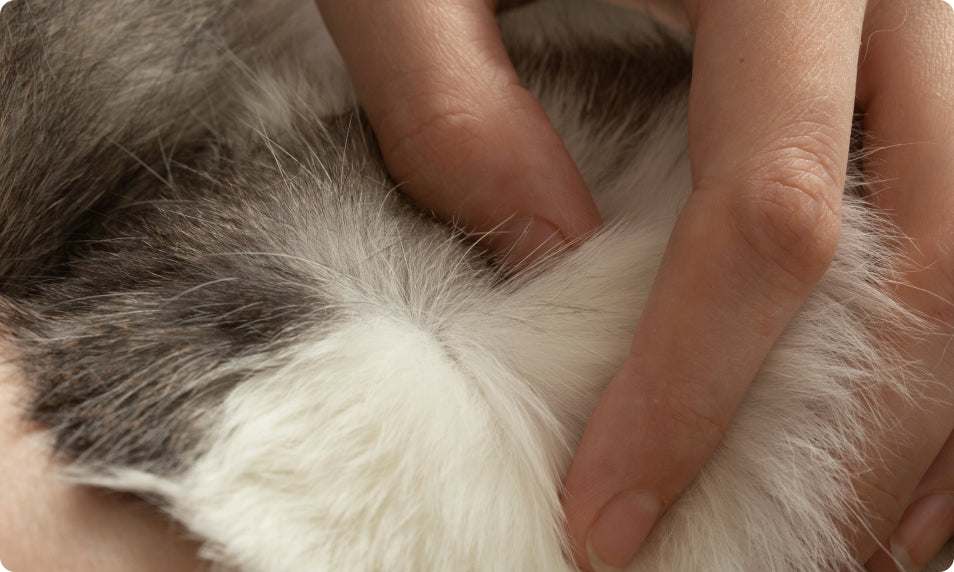
Discover the common skin conditions in cats, their causes, and effective treatments. Learn how to identify symptoms and when to seek veterinary help.


